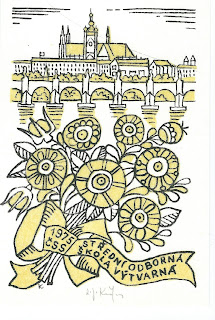Over the years I have stayed in hotels all around the Czech Republic. The standard of Czech hotels tends to vary and it is not always clear without visiting and indeed staying in them which are good and which not. I have learned a lot over the years and I thought I would pass some of that experience on to you.
Star-rating
The star-rating you see on websites can be
misleading. There is a formal Czech body classifying hotels, but most Czech
hotels have not chosen to go that route. The star-listing you see most
of the time is the one the hotel has chosen for itself. I often find
that a 4* hotel is closer to a 3* one in my reckoning but sometimes the
reverse is the case. So look carefully at the facilities and the
photographs on the hotel's website before booking.
Old or New
Many Czech hotels and pensions are in old buildings, which were designed for a different age. That is one of their charms - you might find yourself sleeping in a room with carved beams, an arched ceiling or pillars. You might eat your breakfast in a vaulted cellar. But with this antiquity comes a price. These hotels were not designed for modern conveniences, such as air-conditioning or under-floor heating. What is more, the buildings may be subject to planning controls that limit structural changes. The absence of air-conditioning is a frequent complaint on hotel review sites, usually from Americans as we Europeans regard air-con as an exception. If you want all mod-cons stay in a modern hotel. But if you do so, check where the hotel is in relation to the historic town centre.
Facilities
Czech hotels and pensions in the major cities usually come with en-suite facilities - often in the form of a shower. But in the less touristy areas and in the cheaper accommodation it is worth checking before booking. Sound-proofing in Czech hotels can vary. So it is a good idea not to go for the room with the picturesque view across the town square, unless you are happy to hear people enjoying themselves at night. Increasingly Czech hotels provide free WiFi for their guests. However, the thick walls of some of the older buildings can interfere with reception. If this is important to you, it is worth saying so when booking, as some rooms will have better reception than others.
For British guests it is worth pointing out that there are often no
tea-making facilities in the room. If having a cuppa before you go to
bed matters, bring a kettle. Even where there is a kettle and
packets of tea or coffee, check whether you will be charged for
consumption of a packet. I was really shocked by this the first time I
saw it and now I check. By the way, the tea provided will not be as
strong as we Brits are used to: bring your own or use two bags if you prefer a strong cup. You may
need to buy some milk as that is not always provided. You can nearly
always drink the tap water, unless told not to.
Czech beds
The beds in Czech hotels are usually quite hard; which is something that I like. It is common practice for a double bed to have two single mattresses rather than one double one. Not all Czech hotel receptionists understand the difference between a double and a twin room, so it is better to ask specifically for a room with two beds rather than for a twin.
Breakfast
Most Czech hotel bookings are for bed and breakfast. Breakfast is usually a continental buffet one, although often you will have the choice of scrambled eggs, sausages and even bacon. Some but not all hotels have restaurants. Apartment hotels do not include breakfast in the price, as you have the facility to make it in your apartment, although you may find that they also offer a breakfast for an additional fee.
When you arrive
When you arrive at a Czech hotel you will be asked to show your passport, which may be photocopied or the details entered into a form. This is because Czech hotels are legally required to get this information.
Enjoy your stay.









![By High Contrast (Own work) [CC BY 3.0 de (http://creativecommons.org/licenses/by/3.0/de/deed.en)], via Wikimedia Commons.](https://upload.wikimedia.org/wikipedia/commons/thumb/7/7d/Bus_in_Prague%2C_near_the_main_train_station.jpg/512px-Bus_in_Prague%2C_near_the_main_train_station.jpg)







